HI6028 Taxation Theory, Practice & Law Assignment T2 2019 Analysis
VerifiedAdded on 2022/10/06
|8
|2619
|38
Homework Assignment
AI Summary
This document presents a comprehensive analysis of a taxation assignment, focusing on Goods and Services Tax (GST) and Capital Gains Tax (CGT) within the Australian context. The assignment delves into the input tax credit entitlements of City Sky Co., a property investment and development company, examining the GST implications of legal fees. It then proceeds to analyze the capital gains tax consequences for Emma, evaluating the tax implications of selling a block of land, shares in Rio Tinto, and a stamp collection. The analysis includes detailed calculations, legal issue identification, and application of relevant tax laws to the provided scenarios, offering a practical understanding of taxation principles.
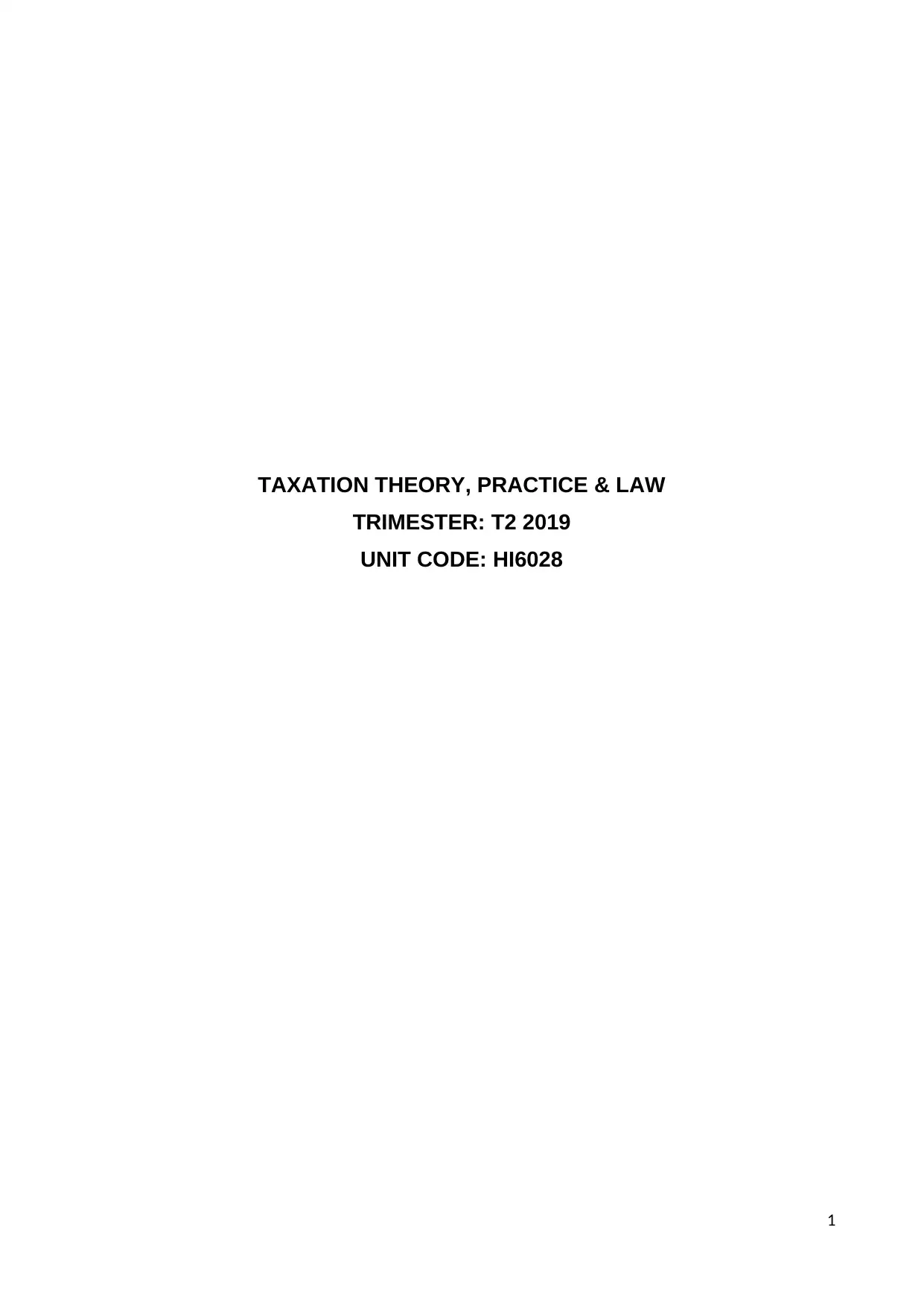
TAXATION THEORY, PRACTICE & LAW
TRIMESTER: T2 2019
UNIT CODE: HI6028
1
TRIMESTER: T2 2019
UNIT CODE: HI6028
1
Paraphrase This Document
Need a fresh take? Get an instant paraphrase of this document with our AI Paraphraser
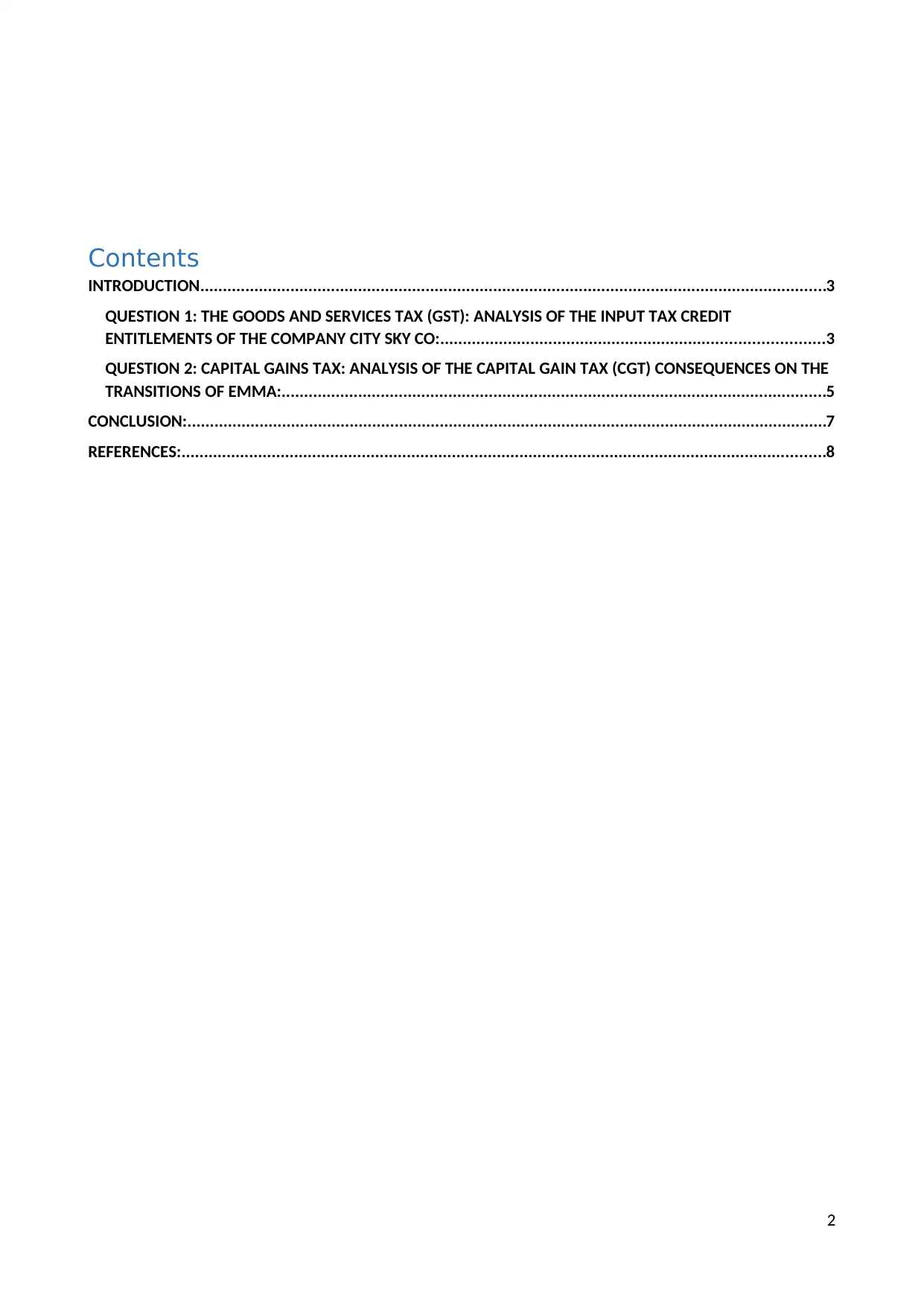
Contents
INTRODUCTION...........................................................................................................................................3
QUESTION 1: THE GOODS AND SERVICES TAX (GST): ANALYSIS OF THE INPUT TAX CREDIT
ENTITLEMENTS OF THE COMPANY CITY SKY CO:.....................................................................................3
QUESTION 2: CAPITAL GAINS TAX: ANALYSIS OF THE CAPITAL GAIN TAX (CGT) CONSEQUENCES ON THE
TRANSITIONS OF EMMA:.........................................................................................................................5
CONCLUSION:..............................................................................................................................................7
REFERENCES:...............................................................................................................................................8
2
INTRODUCTION...........................................................................................................................................3
QUESTION 1: THE GOODS AND SERVICES TAX (GST): ANALYSIS OF THE INPUT TAX CREDIT
ENTITLEMENTS OF THE COMPANY CITY SKY CO:.....................................................................................3
QUESTION 2: CAPITAL GAINS TAX: ANALYSIS OF THE CAPITAL GAIN TAX (CGT) CONSEQUENCES ON THE
TRANSITIONS OF EMMA:.........................................................................................................................5
CONCLUSION:..............................................................................................................................................7
REFERENCES:...............................................................................................................................................8
2
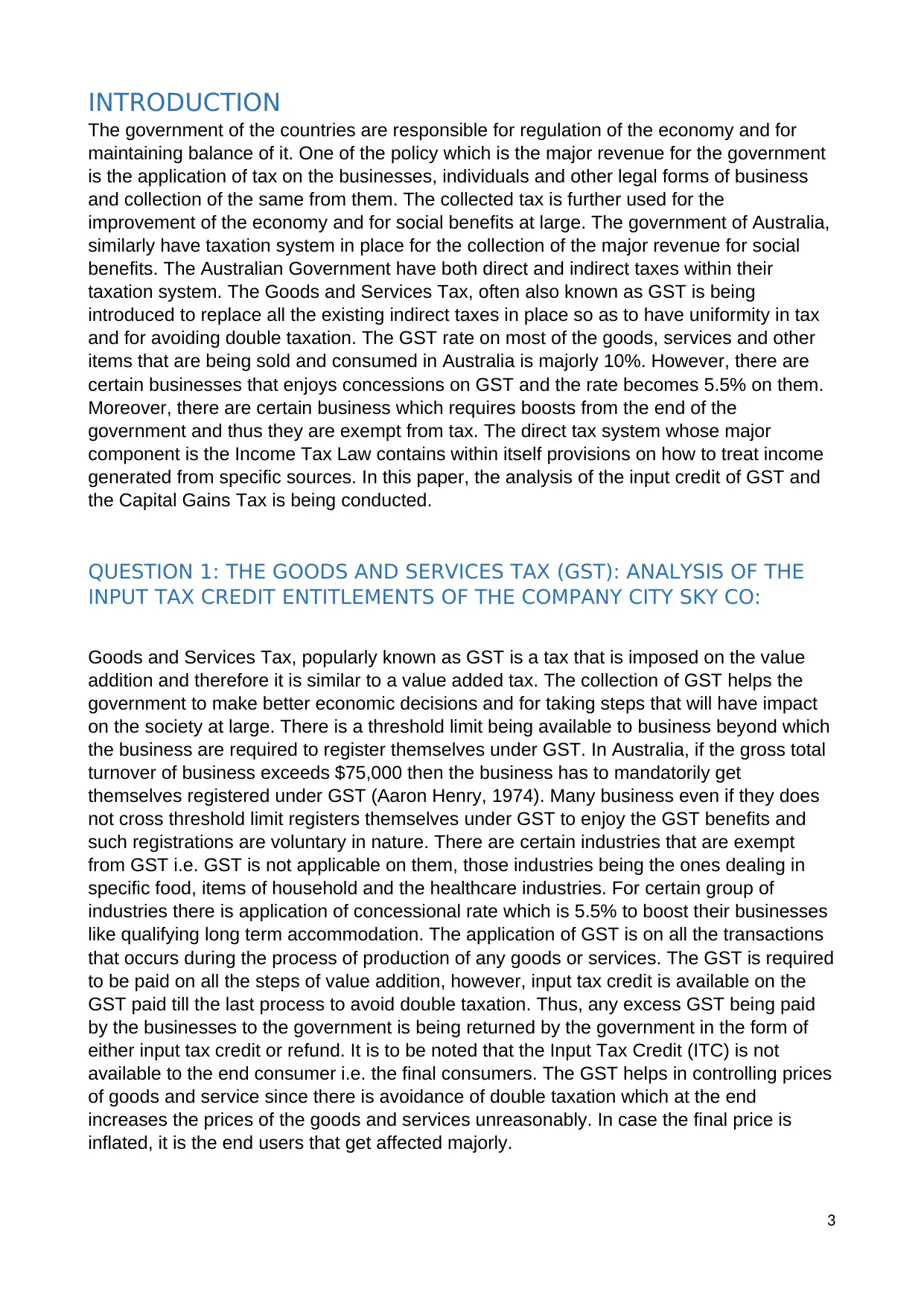
INTRODUCTION
The government of the countries are responsible for regulation of the economy and for
maintaining balance of it. One of the policy which is the major revenue for the government
is the application of tax on the businesses, individuals and other legal forms of business
and collection of the same from them. The collected tax is further used for the
improvement of the economy and for social benefits at large. The government of Australia,
similarly have taxation system in place for the collection of the major revenue for social
benefits. The Australian Government have both direct and indirect taxes within their
taxation system. The Goods and Services Tax, often also known as GST is being
introduced to replace all the existing indirect taxes in place so as to have uniformity in tax
and for avoiding double taxation. The GST rate on most of the goods, services and other
items that are being sold and consumed in Australia is majorly 10%. However, there are
certain businesses that enjoys concessions on GST and the rate becomes 5.5% on them.
Moreover, there are certain business which requires boosts from the end of the
government and thus they are exempt from tax. The direct tax system whose major
component is the Income Tax Law contains within itself provisions on how to treat income
generated from specific sources. In this paper, the analysis of the input credit of GST and
the Capital Gains Tax is being conducted.
QUESTION 1: THE GOODS AND SERVICES TAX (GST): ANALYSIS OF THE
INPUT TAX CREDIT ENTITLEMENTS OF THE COMPANY CITY SKY CO:
Goods and Services Tax, popularly known as GST is a tax that is imposed on the value
addition and therefore it is similar to a value added tax. The collection of GST helps the
government to make better economic decisions and for taking steps that will have impact
on the society at large. There is a threshold limit being available to business beyond which
the business are required to register themselves under GST. In Australia, if the gross total
turnover of business exceeds $75,000 then the business has to mandatorily get
themselves registered under GST (Aaron Henry, 1974). Many business even if they does
not cross threshold limit registers themselves under GST to enjoy the GST benefits and
such registrations are voluntary in nature. There are certain industries that are exempt
from GST i.e. GST is not applicable on them, those industries being the ones dealing in
specific food, items of household and the healthcare industries. For certain group of
industries there is application of concessional rate which is 5.5% to boost their businesses
like qualifying long term accommodation. The application of GST is on all the transactions
that occurs during the process of production of any goods or services. The GST is required
to be paid on all the steps of value addition, however, input tax credit is available on the
GST paid till the last process to avoid double taxation. Thus, any excess GST being paid
by the businesses to the government is being returned by the government in the form of
either input tax credit or refund. It is to be noted that the Input Tax Credit (ITC) is not
available to the end consumer i.e. the final consumers. The GST helps in controlling prices
of goods and service since there is avoidance of double taxation which at the end
increases the prices of the goods and services unreasonably. In case the final price is
inflated, it is the end users that get affected majorly.
3
The government of the countries are responsible for regulation of the economy and for
maintaining balance of it. One of the policy which is the major revenue for the government
is the application of tax on the businesses, individuals and other legal forms of business
and collection of the same from them. The collected tax is further used for the
improvement of the economy and for social benefits at large. The government of Australia,
similarly have taxation system in place for the collection of the major revenue for social
benefits. The Australian Government have both direct and indirect taxes within their
taxation system. The Goods and Services Tax, often also known as GST is being
introduced to replace all the existing indirect taxes in place so as to have uniformity in tax
and for avoiding double taxation. The GST rate on most of the goods, services and other
items that are being sold and consumed in Australia is majorly 10%. However, there are
certain businesses that enjoys concessions on GST and the rate becomes 5.5% on them.
Moreover, there are certain business which requires boosts from the end of the
government and thus they are exempt from tax. The direct tax system whose major
component is the Income Tax Law contains within itself provisions on how to treat income
generated from specific sources. In this paper, the analysis of the input credit of GST and
the Capital Gains Tax is being conducted.
QUESTION 1: THE GOODS AND SERVICES TAX (GST): ANALYSIS OF THE
INPUT TAX CREDIT ENTITLEMENTS OF THE COMPANY CITY SKY CO:
Goods and Services Tax, popularly known as GST is a tax that is imposed on the value
addition and therefore it is similar to a value added tax. The collection of GST helps the
government to make better economic decisions and for taking steps that will have impact
on the society at large. There is a threshold limit being available to business beyond which
the business are required to register themselves under GST. In Australia, if the gross total
turnover of business exceeds $75,000 then the business has to mandatorily get
themselves registered under GST (Aaron Henry, 1974). Many business even if they does
not cross threshold limit registers themselves under GST to enjoy the GST benefits and
such registrations are voluntary in nature. There are certain industries that are exempt
from GST i.e. GST is not applicable on them, those industries being the ones dealing in
specific food, items of household and the healthcare industries. For certain group of
industries there is application of concessional rate which is 5.5% to boost their businesses
like qualifying long term accommodation. The application of GST is on all the transactions
that occurs during the process of production of any goods or services. The GST is required
to be paid on all the steps of value addition, however, input tax credit is available on the
GST paid till the last process to avoid double taxation. Thus, any excess GST being paid
by the businesses to the government is being returned by the government in the form of
either input tax credit or refund. It is to be noted that the Input Tax Credit (ITC) is not
available to the end consumer i.e. the final consumers. The GST helps in controlling prices
of goods and service since there is avoidance of double taxation which at the end
increases the prices of the goods and services unreasonably. In case the final price is
inflated, it is the end users that get affected majorly.
3
⊘ This is a preview!⊘
Do you want full access?
Subscribe today to unlock all pages.

Trusted by 1+ million students worldwide
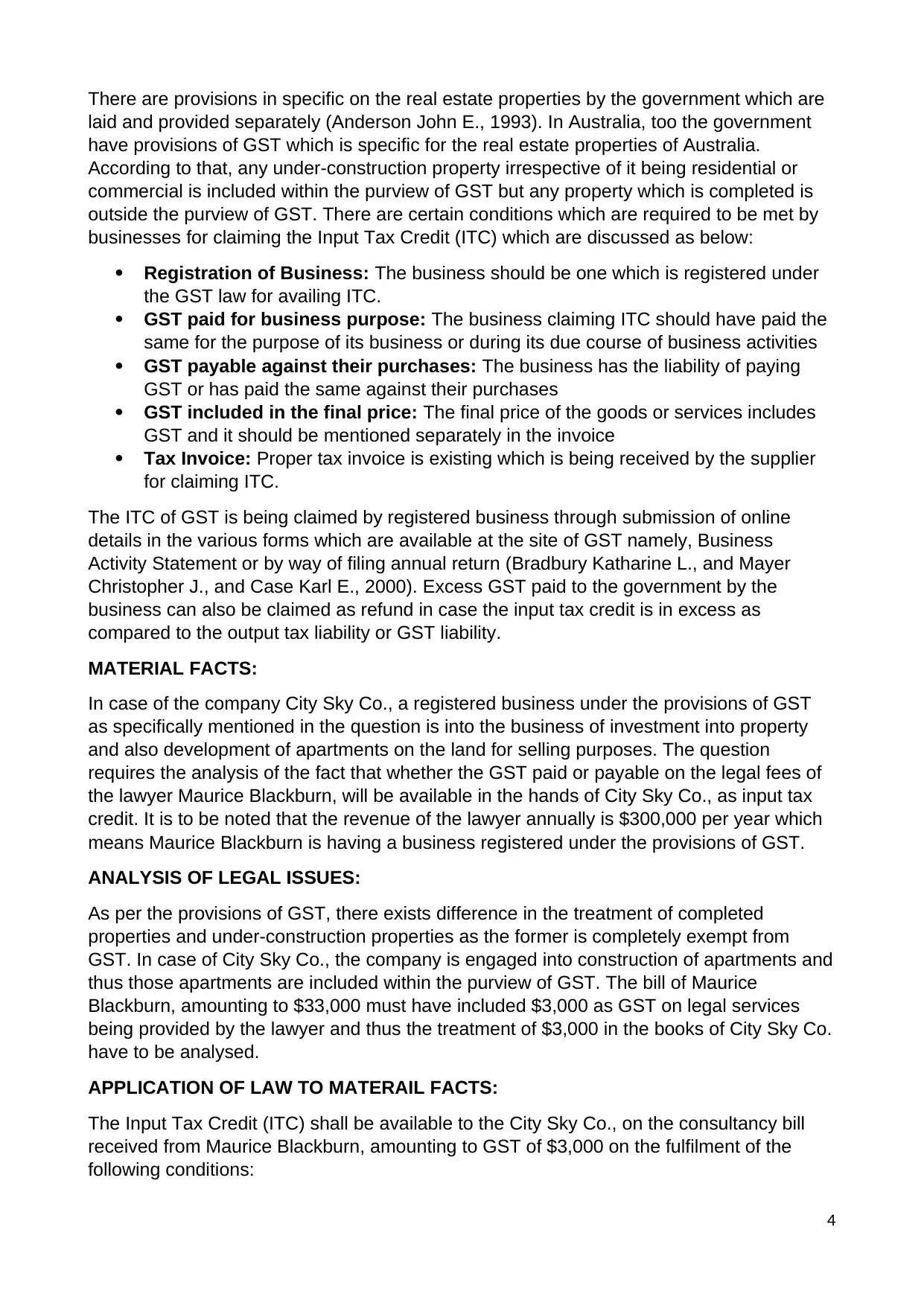
There are provisions in specific on the real estate properties by the government which are
laid and provided separately (Anderson John E., 1993). In Australia, too the government
have provisions of GST which is specific for the real estate properties of Australia.
According to that, any under-construction property irrespective of it being residential or
commercial is included within the purview of GST but any property which is completed is
outside the purview of GST. There are certain conditions which are required to be met by
businesses for claiming the Input Tax Credit (ITC) which are discussed as below:
Registration of Business: The business should be one which is registered under
the GST law for availing ITC.
GST paid for business purpose: The business claiming ITC should have paid the
same for the purpose of its business or during its due course of business activities
GST payable against their purchases: The business has the liability of paying
GST or has paid the same against their purchases
GST included in the final price: The final price of the goods or services includes
GST and it should be mentioned separately in the invoice
Tax Invoice: Proper tax invoice is existing which is being received by the supplier
for claiming ITC.
The ITC of GST is being claimed by registered business through submission of online
details in the various forms which are available at the site of GST namely, Business
Activity Statement or by way of filing annual return (Bradbury Katharine L., and Mayer
Christopher J., and Case Karl E., 2000). Excess GST paid to the government by the
business can also be claimed as refund in case the input tax credit is in excess as
compared to the output tax liability or GST liability.
MATERIAL FACTS:
In case of the company City Sky Co., a registered business under the provisions of GST
as specifically mentioned in the question is into the business of investment into property
and also development of apartments on the land for selling purposes. The question
requires the analysis of the fact that whether the GST paid or payable on the legal fees of
the lawyer Maurice Blackburn, will be available in the hands of City Sky Co., as input tax
credit. It is to be noted that the revenue of the lawyer annually is $300,000 per year which
means Maurice Blackburn is having a business registered under the provisions of GST.
ANALYSIS OF LEGAL ISSUES:
As per the provisions of GST, there exists difference in the treatment of completed
properties and under-construction properties as the former is completely exempt from
GST. In case of City Sky Co., the company is engaged into construction of apartments and
thus those apartments are included within the purview of GST. The bill of Maurice
Blackburn, amounting to $33,000 must have included $3,000 as GST on legal services
being provided by the lawyer and thus the treatment of $3,000 in the books of City Sky Co.
have to be analysed.
APPLICATION OF LAW TO MATERAIL FACTS:
The Input Tax Credit (ITC) shall be available to the City Sky Co., on the consultancy bill
received from Maurice Blackburn, amounting to GST of $3,000 on the fulfilment of the
following conditions:
4
laid and provided separately (Anderson John E., 1993). In Australia, too the government
have provisions of GST which is specific for the real estate properties of Australia.
According to that, any under-construction property irrespective of it being residential or
commercial is included within the purview of GST but any property which is completed is
outside the purview of GST. There are certain conditions which are required to be met by
businesses for claiming the Input Tax Credit (ITC) which are discussed as below:
Registration of Business: The business should be one which is registered under
the GST law for availing ITC.
GST paid for business purpose: The business claiming ITC should have paid the
same for the purpose of its business or during its due course of business activities
GST payable against their purchases: The business has the liability of paying
GST or has paid the same against their purchases
GST included in the final price: The final price of the goods or services includes
GST and it should be mentioned separately in the invoice
Tax Invoice: Proper tax invoice is existing which is being received by the supplier
for claiming ITC.
The ITC of GST is being claimed by registered business through submission of online
details in the various forms which are available at the site of GST namely, Business
Activity Statement or by way of filing annual return (Bradbury Katharine L., and Mayer
Christopher J., and Case Karl E., 2000). Excess GST paid to the government by the
business can also be claimed as refund in case the input tax credit is in excess as
compared to the output tax liability or GST liability.
MATERIAL FACTS:
In case of the company City Sky Co., a registered business under the provisions of GST
as specifically mentioned in the question is into the business of investment into property
and also development of apartments on the land for selling purposes. The question
requires the analysis of the fact that whether the GST paid or payable on the legal fees of
the lawyer Maurice Blackburn, will be available in the hands of City Sky Co., as input tax
credit. It is to be noted that the revenue of the lawyer annually is $300,000 per year which
means Maurice Blackburn is having a business registered under the provisions of GST.
ANALYSIS OF LEGAL ISSUES:
As per the provisions of GST, there exists difference in the treatment of completed
properties and under-construction properties as the former is completely exempt from
GST. In case of City Sky Co., the company is engaged into construction of apartments and
thus those apartments are included within the purview of GST. The bill of Maurice
Blackburn, amounting to $33,000 must have included $3,000 as GST on legal services
being provided by the lawyer and thus the treatment of $3,000 in the books of City Sky Co.
have to be analysed.
APPLICATION OF LAW TO MATERAIL FACTS:
The Input Tax Credit (ITC) shall be available to the City Sky Co., on the consultancy bill
received from Maurice Blackburn, amounting to GST of $3,000 on the fulfilment of the
following conditions:
4
Paraphrase This Document
Need a fresh take? Get an instant paraphrase of this document with our AI Paraphraser
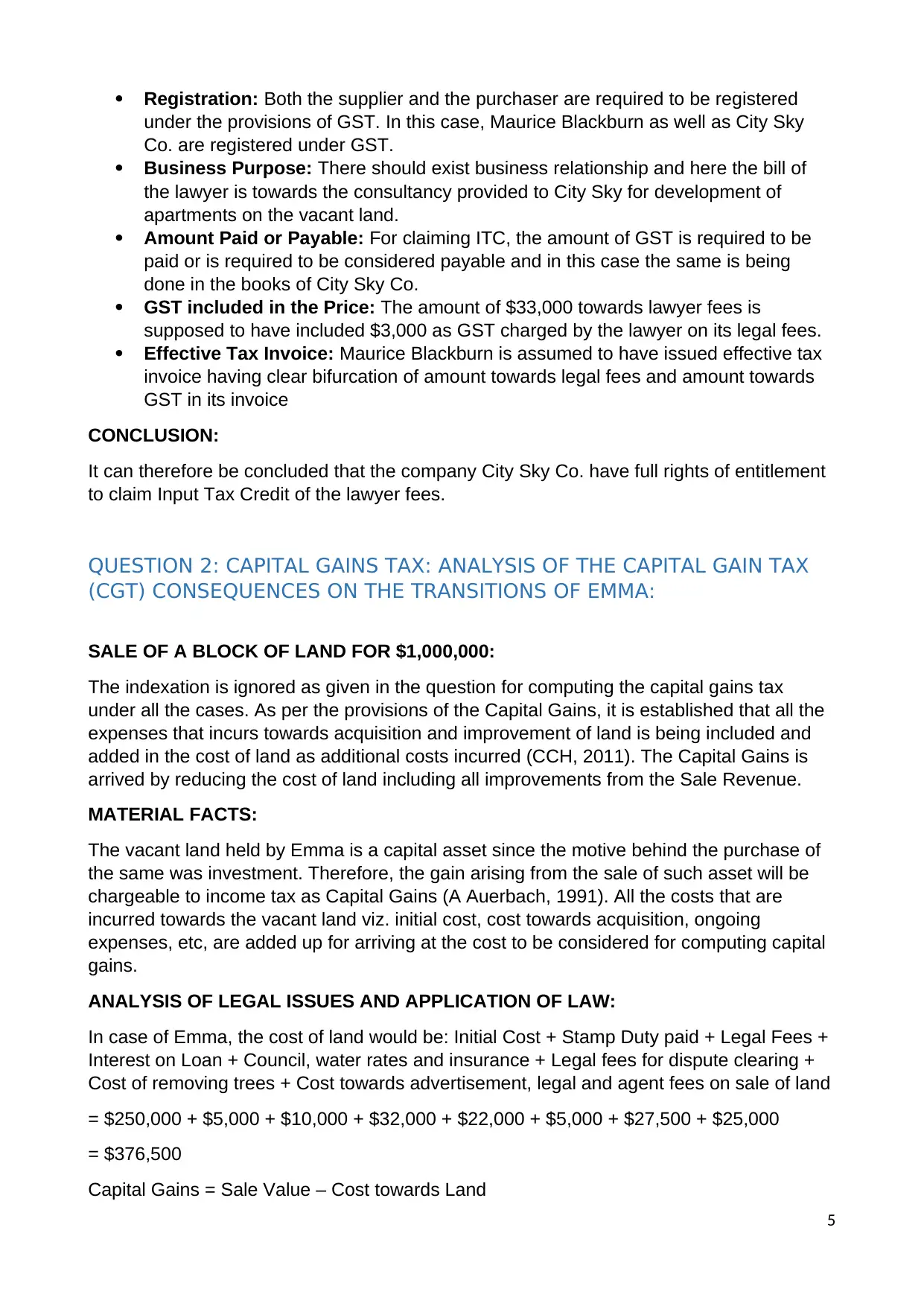
Registration: Both the supplier and the purchaser are required to be registered
under the provisions of GST. In this case, Maurice Blackburn as well as City Sky
Co. are registered under GST.
Business Purpose: There should exist business relationship and here the bill of
the lawyer is towards the consultancy provided to City Sky for development of
apartments on the vacant land.
Amount Paid or Payable: For claiming ITC, the amount of GST is required to be
paid or is required to be considered payable and in this case the same is being
done in the books of City Sky Co.
GST included in the Price: The amount of $33,000 towards lawyer fees is
supposed to have included $3,000 as GST charged by the lawyer on its legal fees.
Effective Tax Invoice: Maurice Blackburn is assumed to have issued effective tax
invoice having clear bifurcation of amount towards legal fees and amount towards
GST in its invoice
CONCLUSION:
It can therefore be concluded that the company City Sky Co. have full rights of entitlement
to claim Input Tax Credit of the lawyer fees.
QUESTION 2: CAPITAL GAINS TAX: ANALYSIS OF THE CAPITAL GAIN TAX
(CGT) CONSEQUENCES ON THE TRANSITIONS OF EMMA:
SALE OF A BLOCK OF LAND FOR $1,000,000:
The indexation is ignored as given in the question for computing the capital gains tax
under all the cases. As per the provisions of the Capital Gains, it is established that all the
expenses that incurs towards acquisition and improvement of land is being included and
added in the cost of land as additional costs incurred (CCH, 2011). The Capital Gains is
arrived by reducing the cost of land including all improvements from the Sale Revenue.
MATERIAL FACTS:
The vacant land held by Emma is a capital asset since the motive behind the purchase of
the same was investment. Therefore, the gain arising from the sale of such asset will be
chargeable to income tax as Capital Gains (A Auerbach, 1991). All the costs that are
incurred towards the vacant land viz. initial cost, cost towards acquisition, ongoing
expenses, etc, are added up for arriving at the cost to be considered for computing capital
gains.
ANALYSIS OF LEGAL ISSUES AND APPLICATION OF LAW:
In case of Emma, the cost of land would be: Initial Cost + Stamp Duty paid + Legal Fees +
Interest on Loan + Council, water rates and insurance + Legal fees for dispute clearing +
Cost of removing trees + Cost towards advertisement, legal and agent fees on sale of land
= $250,000 + $5,000 + $10,000 + $32,000 + $22,000 + $5,000 + $27,500 + $25,000
= $376,500
Capital Gains = Sale Value – Cost towards Land
5
under the provisions of GST. In this case, Maurice Blackburn as well as City Sky
Co. are registered under GST.
Business Purpose: There should exist business relationship and here the bill of
the lawyer is towards the consultancy provided to City Sky for development of
apartments on the vacant land.
Amount Paid or Payable: For claiming ITC, the amount of GST is required to be
paid or is required to be considered payable and in this case the same is being
done in the books of City Sky Co.
GST included in the Price: The amount of $33,000 towards lawyer fees is
supposed to have included $3,000 as GST charged by the lawyer on its legal fees.
Effective Tax Invoice: Maurice Blackburn is assumed to have issued effective tax
invoice having clear bifurcation of amount towards legal fees and amount towards
GST in its invoice
CONCLUSION:
It can therefore be concluded that the company City Sky Co. have full rights of entitlement
to claim Input Tax Credit of the lawyer fees.
QUESTION 2: CAPITAL GAINS TAX: ANALYSIS OF THE CAPITAL GAIN TAX
(CGT) CONSEQUENCES ON THE TRANSITIONS OF EMMA:
SALE OF A BLOCK OF LAND FOR $1,000,000:
The indexation is ignored as given in the question for computing the capital gains tax
under all the cases. As per the provisions of the Capital Gains, it is established that all the
expenses that incurs towards acquisition and improvement of land is being included and
added in the cost of land as additional costs incurred (CCH, 2011). The Capital Gains is
arrived by reducing the cost of land including all improvements from the Sale Revenue.
MATERIAL FACTS:
The vacant land held by Emma is a capital asset since the motive behind the purchase of
the same was investment. Therefore, the gain arising from the sale of such asset will be
chargeable to income tax as Capital Gains (A Auerbach, 1991). All the costs that are
incurred towards the vacant land viz. initial cost, cost towards acquisition, ongoing
expenses, etc, are added up for arriving at the cost to be considered for computing capital
gains.
ANALYSIS OF LEGAL ISSUES AND APPLICATION OF LAW:
In case of Emma, the cost of land would be: Initial Cost + Stamp Duty paid + Legal Fees +
Interest on Loan + Council, water rates and insurance + Legal fees for dispute clearing +
Cost of removing trees + Cost towards advertisement, legal and agent fees on sale of land
= $250,000 + $5,000 + $10,000 + $32,000 + $22,000 + $5,000 + $27,500 + $25,000
= $376,500
Capital Gains = Sale Value – Cost towards Land
5
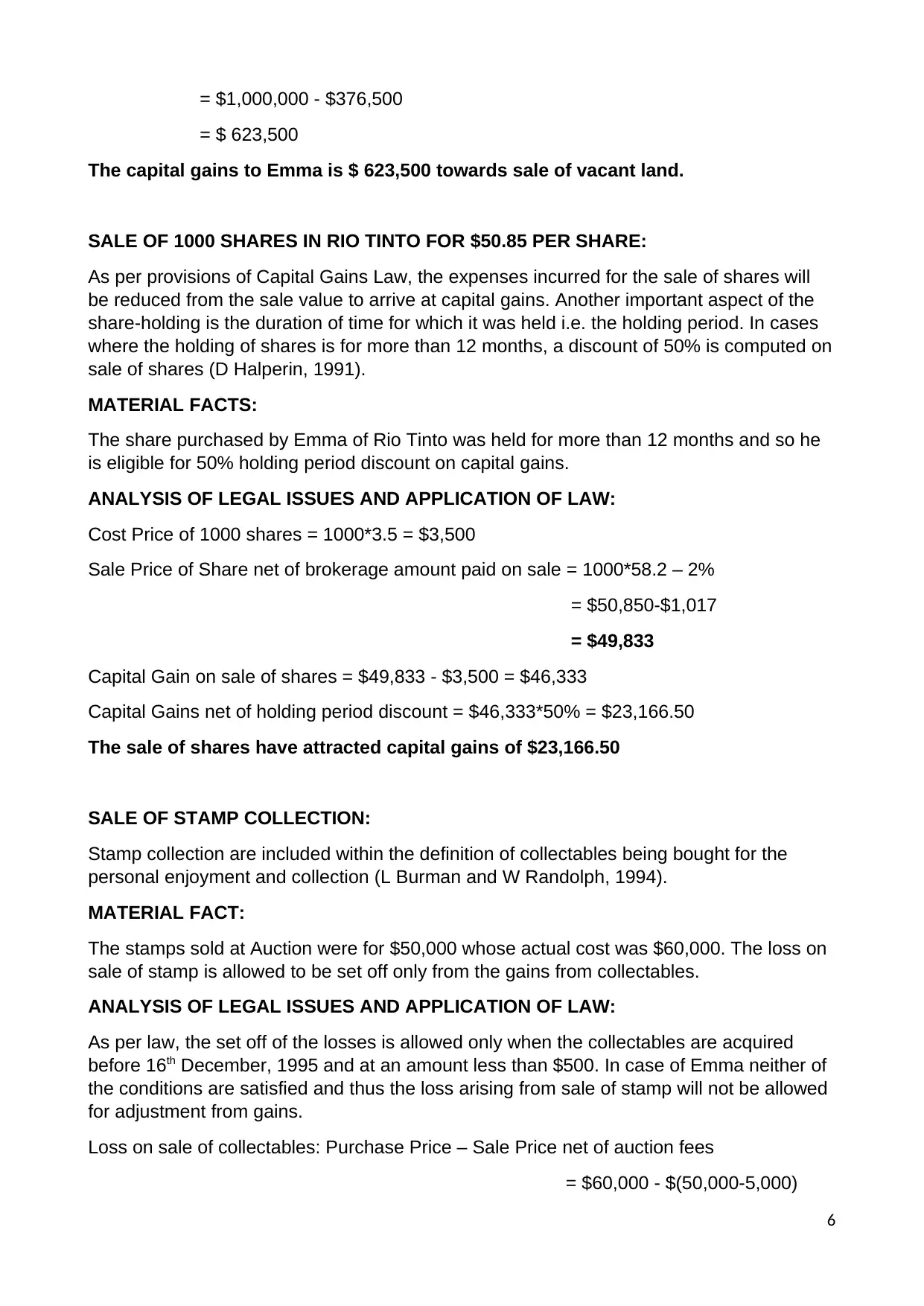
= $1,000,000 - $376,500
= $ 623,500
The capital gains to Emma is $ 623,500 towards sale of vacant land.
SALE OF 1000 SHARES IN RIO TINTO FOR $50.85 PER SHARE:
As per provisions of Capital Gains Law, the expenses incurred for the sale of shares will
be reduced from the sale value to arrive at capital gains. Another important aspect of the
share-holding is the duration of time for which it was held i.e. the holding period. In cases
where the holding of shares is for more than 12 months, a discount of 50% is computed on
sale of shares (D Halperin, 1991).
MATERIAL FACTS:
The share purchased by Emma of Rio Tinto was held for more than 12 months and so he
is eligible for 50% holding period discount on capital gains.
ANALYSIS OF LEGAL ISSUES AND APPLICATION OF LAW:
Cost Price of 1000 shares = 1000*3.5 = $3,500
Sale Price of Share net of brokerage amount paid on sale = 1000*58.2 – 2%
= $50,850-$1,017
= $49,833
Capital Gain on sale of shares = $49,833 - $3,500 = $46,333
Capital Gains net of holding period discount = $46,333*50% = $23,166.50
The sale of shares have attracted capital gains of $23,166.50
SALE OF STAMP COLLECTION:
Stamp collection are included within the definition of collectables being bought for the
personal enjoyment and collection (L Burman and W Randolph, 1994).
MATERIAL FACT:
The stamps sold at Auction were for $50,000 whose actual cost was $60,000. The loss on
sale of stamp is allowed to be set off only from the gains from collectables.
ANALYSIS OF LEGAL ISSUES AND APPLICATION OF LAW:
As per law, the set off of the losses is allowed only when the collectables are acquired
before 16th December, 1995 and at an amount less than $500. In case of Emma neither of
the conditions are satisfied and thus the loss arising from sale of stamp will not be allowed
for adjustment from gains.
Loss on sale of collectables: Purchase Price – Sale Price net of auction fees
= $60,000 - $(50,000-5,000)
6
= $ 623,500
The capital gains to Emma is $ 623,500 towards sale of vacant land.
SALE OF 1000 SHARES IN RIO TINTO FOR $50.85 PER SHARE:
As per provisions of Capital Gains Law, the expenses incurred for the sale of shares will
be reduced from the sale value to arrive at capital gains. Another important aspect of the
share-holding is the duration of time for which it was held i.e. the holding period. In cases
where the holding of shares is for more than 12 months, a discount of 50% is computed on
sale of shares (D Halperin, 1991).
MATERIAL FACTS:
The share purchased by Emma of Rio Tinto was held for more than 12 months and so he
is eligible for 50% holding period discount on capital gains.
ANALYSIS OF LEGAL ISSUES AND APPLICATION OF LAW:
Cost Price of 1000 shares = 1000*3.5 = $3,500
Sale Price of Share net of brokerage amount paid on sale = 1000*58.2 – 2%
= $50,850-$1,017
= $49,833
Capital Gain on sale of shares = $49,833 - $3,500 = $46,333
Capital Gains net of holding period discount = $46,333*50% = $23,166.50
The sale of shares have attracted capital gains of $23,166.50
SALE OF STAMP COLLECTION:
Stamp collection are included within the definition of collectables being bought for the
personal enjoyment and collection (L Burman and W Randolph, 1994).
MATERIAL FACT:
The stamps sold at Auction were for $50,000 whose actual cost was $60,000. The loss on
sale of stamp is allowed to be set off only from the gains from collectables.
ANALYSIS OF LEGAL ISSUES AND APPLICATION OF LAW:
As per law, the set off of the losses is allowed only when the collectables are acquired
before 16th December, 1995 and at an amount less than $500. In case of Emma neither of
the conditions are satisfied and thus the loss arising from sale of stamp will not be allowed
for adjustment from gains.
Loss on sale of collectables: Purchase Price – Sale Price net of auction fees
= $60,000 - $(50,000-5,000)
6
⊘ This is a preview!⊘
Do you want full access?
Subscribe today to unlock all pages.

Trusted by 1+ million students worldwide
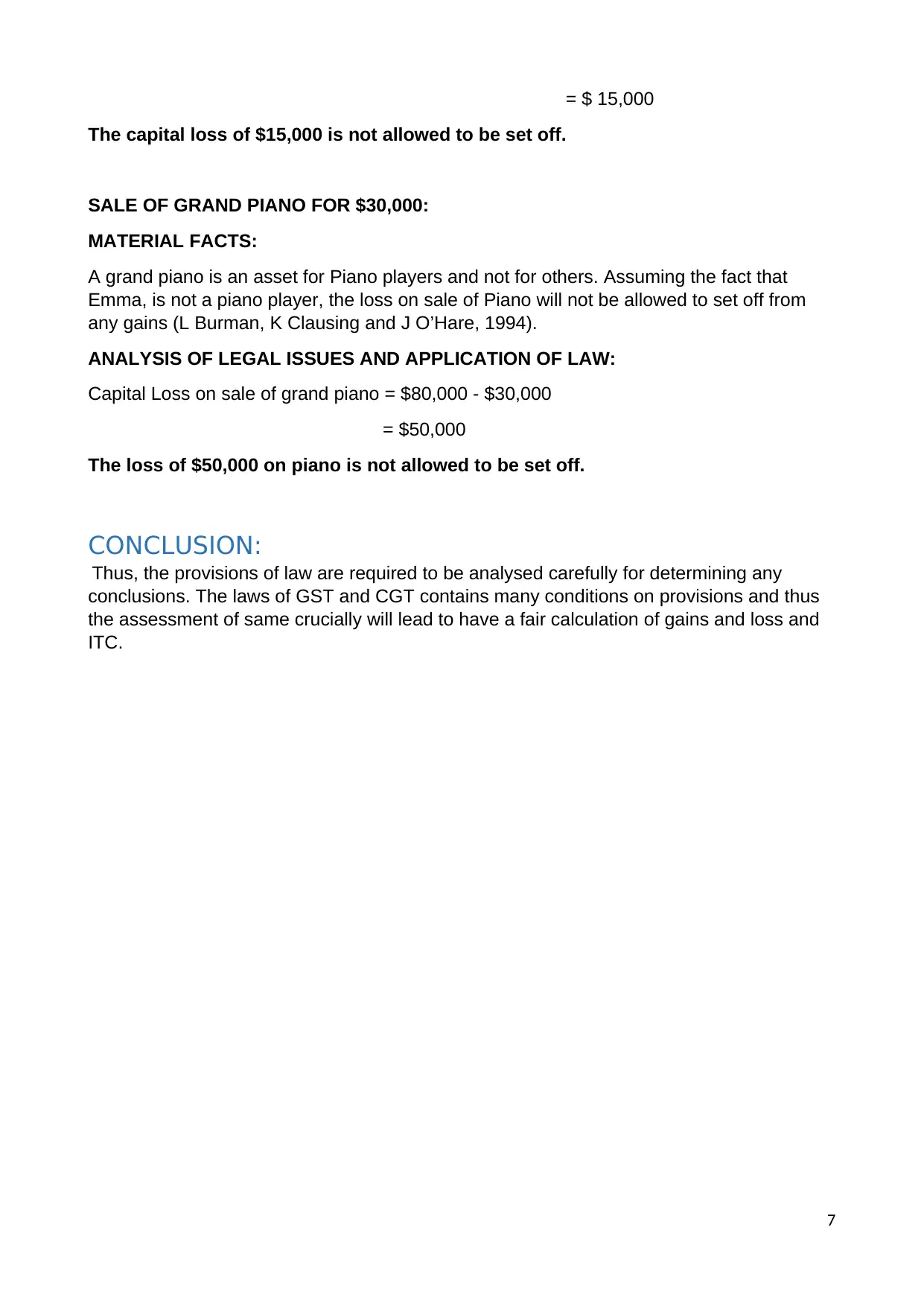
= $ 15,000
The capital loss of $15,000 is not allowed to be set off.
SALE OF GRAND PIANO FOR $30,000:
MATERIAL FACTS:
A grand piano is an asset for Piano players and not for others. Assuming the fact that
Emma, is not a piano player, the loss on sale of Piano will not be allowed to set off from
any gains (L Burman, K Clausing and J O’Hare, 1994).
ANALYSIS OF LEGAL ISSUES AND APPLICATION OF LAW:
Capital Loss on sale of grand piano = $80,000 - $30,000
= $50,000
The loss of $50,000 on piano is not allowed to be set off.
CONCLUSION:
Thus, the provisions of law are required to be analysed carefully for determining any
conclusions. The laws of GST and CGT contains many conditions on provisions and thus
the assessment of same crucially will lead to have a fair calculation of gains and loss and
ITC.
7
The capital loss of $15,000 is not allowed to be set off.
SALE OF GRAND PIANO FOR $30,000:
MATERIAL FACTS:
A grand piano is an asset for Piano players and not for others. Assuming the fact that
Emma, is not a piano player, the loss on sale of Piano will not be allowed to set off from
any gains (L Burman, K Clausing and J O’Hare, 1994).
ANALYSIS OF LEGAL ISSUES AND APPLICATION OF LAW:
Capital Loss on sale of grand piano = $80,000 - $30,000
= $50,000
The loss of $50,000 on piano is not allowed to be set off.
CONCLUSION:
Thus, the provisions of law are required to be analysed carefully for determining any
conclusions. The laws of GST and CGT contains many conditions on provisions and thus
the assessment of same crucially will lead to have a fair calculation of gains and loss and
ITC.
7
Paraphrase This Document
Need a fresh take? Get an instant paraphrase of this document with our AI Paraphraser
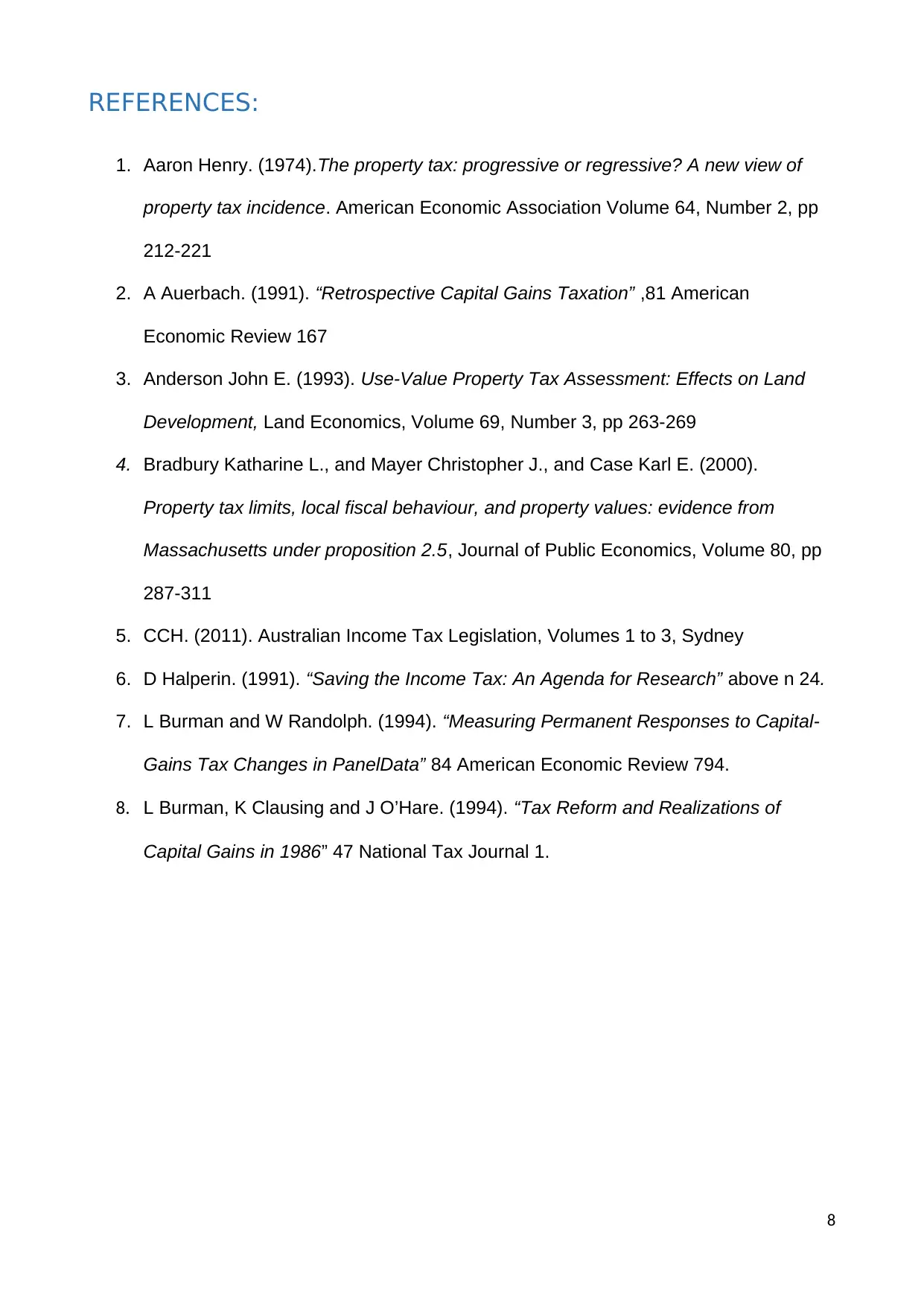
REFERENCES:
1. Aaron Henry. (1974).The property tax: progressive or regressive? A new view of
property tax incidence. American Economic Association Volume 64, Number 2, pp
212-221
2. A Auerbach. (1991). “Retrospective Capital Gains Taxation” ,81 American
Economic Review 167
3. Anderson John E. (1993). Use-Value Property Tax Assessment: Effects on Land
Development, Land Economics, Volume 69, Number 3, pp 263-269
4. Bradbury Katharine L., and Mayer Christopher J., and Case Karl E. (2000).
Property tax limits, local fiscal behaviour, and property values: evidence from
Massachusetts under proposition 2.5, Journal of Public Economics, Volume 80, pp
287-311
5. CCH. (2011). Australian Income Tax Legislation, Volumes 1 to 3, Sydney
6. D Halperin. (1991). “Saving the Income Tax: An Agenda for Research” above n 24.
7. L Burman and W Randolph. (1994). “Measuring Permanent Responses to Capital-
Gains Tax Changes in PanelData” 84 American Economic Review 794.
8. L Burman, K Clausing and J O’Hare. (1994). “Tax Reform and Realizations of
Capital Gains in 1986” 47 National Tax Journal 1.
8
1. Aaron Henry. (1974).The property tax: progressive or regressive? A new view of
property tax incidence. American Economic Association Volume 64, Number 2, pp
212-221
2. A Auerbach. (1991). “Retrospective Capital Gains Taxation” ,81 American
Economic Review 167
3. Anderson John E. (1993). Use-Value Property Tax Assessment: Effects on Land
Development, Land Economics, Volume 69, Number 3, pp 263-269
4. Bradbury Katharine L., and Mayer Christopher J., and Case Karl E. (2000).
Property tax limits, local fiscal behaviour, and property values: evidence from
Massachusetts under proposition 2.5, Journal of Public Economics, Volume 80, pp
287-311
5. CCH. (2011). Australian Income Tax Legislation, Volumes 1 to 3, Sydney
6. D Halperin. (1991). “Saving the Income Tax: An Agenda for Research” above n 24.
7. L Burman and W Randolph. (1994). “Measuring Permanent Responses to Capital-
Gains Tax Changes in PanelData” 84 American Economic Review 794.
8. L Burman, K Clausing and J O’Hare. (1994). “Tax Reform and Realizations of
Capital Gains in 1986” 47 National Tax Journal 1.
8
1 out of 8
Related Documents
Your All-in-One AI-Powered Toolkit for Academic Success.
+13062052269
info@desklib.com
Available 24*7 on WhatsApp / Email
![[object Object]](/_next/static/media/star-bottom.7253800d.svg)
Unlock your academic potential
Copyright © 2020–2025 A2Z Services. All Rights Reserved. Developed and managed by ZUCOL.





